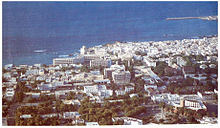| Mogadishu Riots of 1989 | |
|---|---|
| Part of Somali Rebellion | |
 Mogadishu in the 1980's | |
| Native name | Jimcaha Madoow (Black Friday) |
| Location | Mogadishu, Somalia |
| Date | 14 July 1989 |
| Deaths | Approx. 400 civilians killed |
| Injured | Approx. 1,000+ civilians injured[1] |
| Perpetrators | Siad Barre regime |
The Mogadishu riots of July 1989 (Somali: Jimcaha Madoow, lit. 'Black Friday') were a series of violent events that took place in the capital city of Somalia on 14 and 15 July 1989. A significant event in modern Somali history, the riot and killings that followed were the first serious violence Mogadishu had seen and preluded the approaching Somali Civil War. The event was sparked by the assassination of Roman Catholic Bishop of Mogadishu Salvatore Colombo and the subsequent arrest of several Muslim religious leaders by the Barre regime.
According to human rights groups and independent sources, the violence, which was overwhelmingly carried out by government forces, resulted in approximately 400 killed and over 1,000 injured. The Somali government, however, denied these reports and claimed that only 23 people died and 59 were injured. In the aftermath of the riots, around 2,000 people were arrested and 46 men from the Isaaq clan were summarily executed by the military outside Mogadishu in an event now known as the Jazeera Beach Massacre.
The explosion of violence in the capital led to international condemnation towards the Barre regime, withdrawals of foreign support and inflamed anti government sentiments.
- ^ "Somalia Executes 46 After Rioting". The New York Times. 22 July 1989.